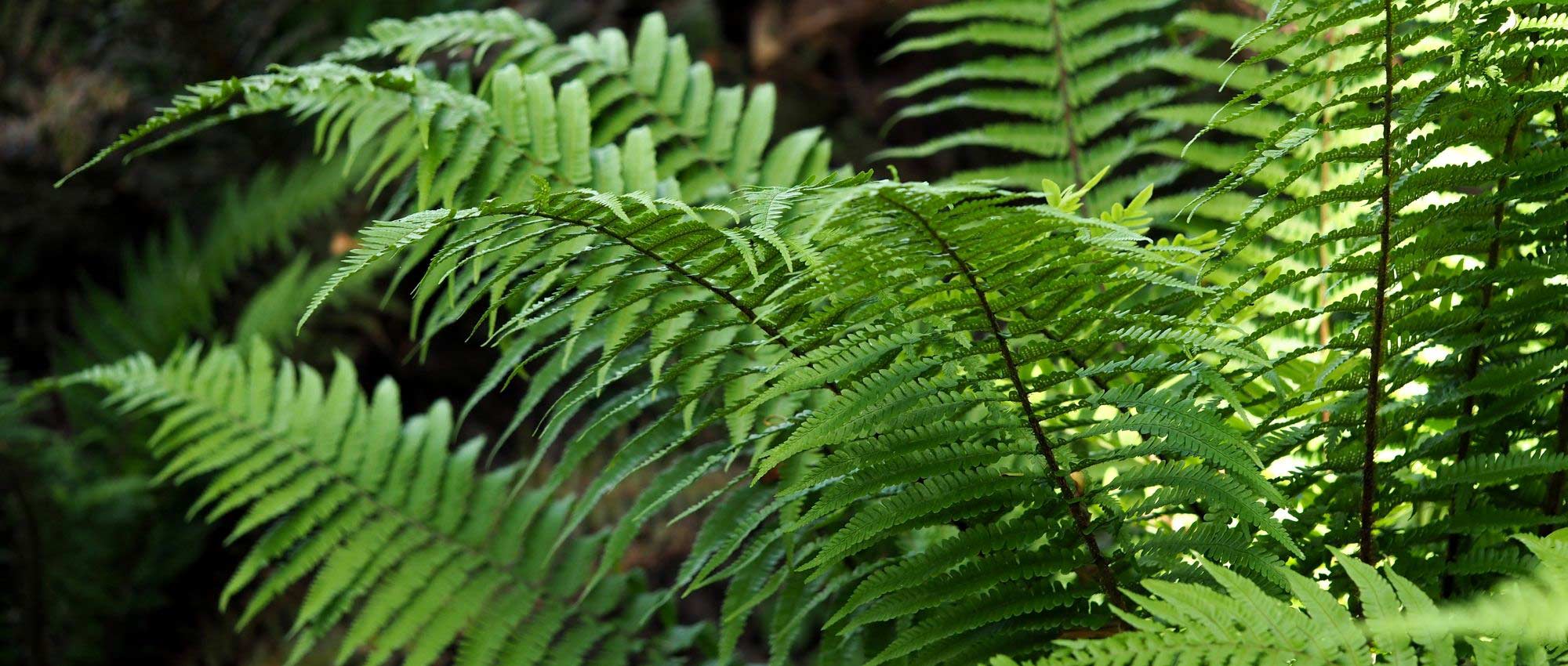
Dryopteris: planting, growing and care
Contents
Dryopteris in a nutshell
- Dryopteris are valued for their elegant, architectural green fronds
- These ferns are ideal in woodland gardens, but also suit urban, architectural and contemporary gardens
- Depending on species and climate, they can be deciduous or evergreen
- Some, such as Dryopteris erythrosora, display attractive colourful hues
- Hardy plants, little affected by pests and diseases
- They thrive in shaded positions, in fresh, humus-bearing soil
A word from our Expert
Dryopteris are superb ferns that form clumps of erect, spreading fronds. They are remarkably elegant and graphic. They can be deciduous or evergreen, depending on species and climate. In spring they produce superb croziers that unfurl to reveal majestic fronds. There are about 300 species, some of which grow wild in France, in French forests. Among them, Dryopteris filix-mas, or male fern, is a robust species with large green deciduous fronds. In the garden, other Dryopteris are very interesting for their colours, such as Dryopteris erythrosora, which in spring takes on coppery-pink tones. Dryopteris wallichiana, for its part, bears fronds of a beautiful glossy green, contrasted by a brown central axis (rachis).
Dryopteris are robust and quite hardy plants. They are fairly easy to grow and are seldom affected by disease or pests. They thrive in cool, shaded positions, sheltered from scorching sun, in humus-bearing, light soil. They are ideal plants to place in woodland understorey or in a naturalistic garden, but also in a shaded rockery or around a pond. They also find a place in mixed borders. They bring a lush, very green and graphic effect to the garden and create a plant backdrop that showcases more colourful blooms.
Botany
Botanical data
- Latin name Dryopteris sp.
- Family Dryopteridaceae
- Common name Fern, Dryopteris, Male fern...
- Flowering none
- Height up to 1.20 m - 1.50 m
- Sun exposure shade or partial shade
- Soil type fresh, humus-bearing
- Hardiness generally very good, between –20 and –25 °C
Dryopteris are ferns that form clumps of divided, fairly large fronds. They represent a fairly large group, with about 300 species. They occur mainly in temperate zones of Northern Hemisphere. Greatest diversity is in East Asia, although they are also found on other continents such as Europe and North America. Best known is Dryopteris filix-mas, also called Male fern, which occurs wild in France.
Like many ferns, Dryopteris grow mainly in forest, on fresh, humus-bearing soil. They are also found at edges of watercourses and sometimes in rocky areas. In the garden, therefore, grow them in shade or partial shade in a cool or damp environment.
Ferns are primitive, very ancient plants. They make up group Pteridophyta, together with horsetails and clubmosses. Dryopteris gave their name to family Dryopteridaceae (1,870 species), including Polystichum, another group of ferns grown for ornamental interest.
Etymologically, name Dryopteris comes from Greek dryas: oak, and pteris: fern, because some Dryopteris grow in oak woods. This can cause confusion with another fern species, Gymnocarpium dryopteris, also present in French forests but quite different from true Dryopteris.
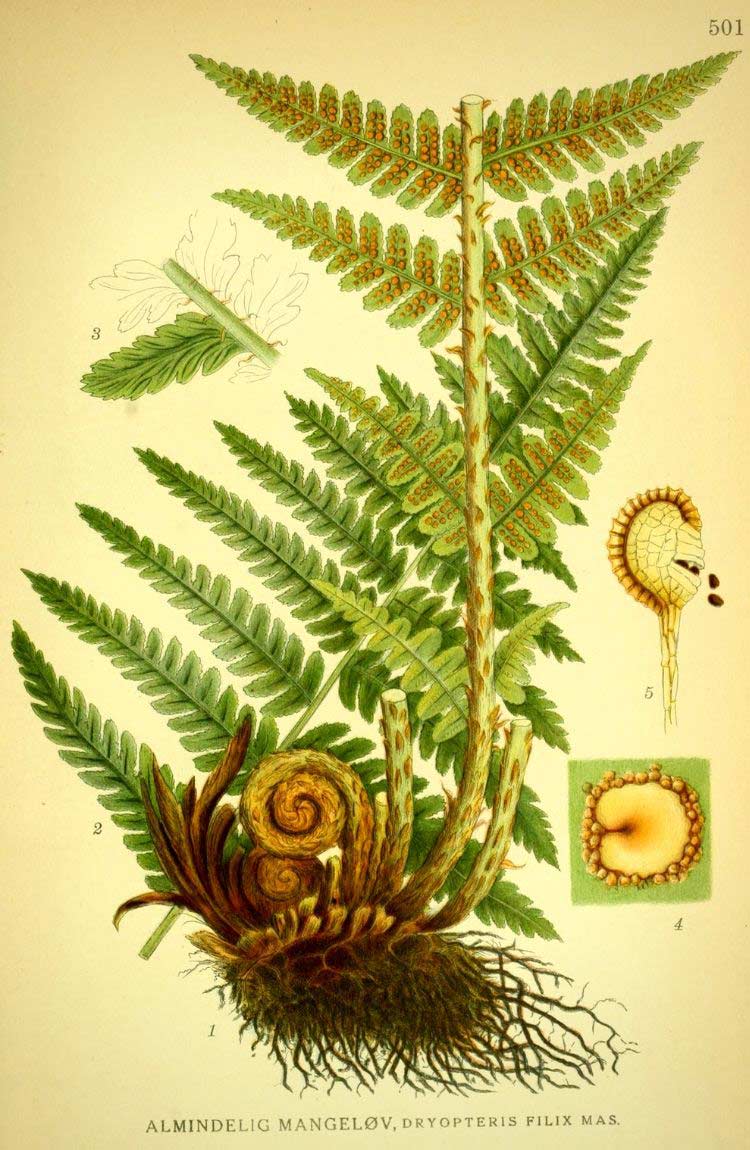
Dryopteris filix-mas: Botanical illustration
Dryopteris form clumps from which divided fronds emerge, creating a flared effect. Fronds arise directly from this stump and are neatly arranged in a crown. Most Dryopteris measure between 60 cm and 1.50 m in height. Dryopteris goldieana, Dryopteris affinis and Dryopteris filix-mas are among largest (between 1 m and 1.50 m), while Dryopteris marginalis, Dryopteris cycadina and Dryopteris sieboldii are much smaller. Ferns have a distinctive silhouette: slender, light and graphic.
Dryopteris have short rootstocks, from which fronds develop. These are underground stems that grow horizontally or erect, and develop slowly.
Ferns have a very particular mode of reproduction: they produce neither flowers nor seeds. They produce, generally on underside of fronds, spores to reproduce. Spores are enclosed in sporangia, which open at ripeness, themselves grouped in sori. In Dryopteris, these sori, or clusters of sporangia, are protected by a small kidney-shaped indusium. Spores are released and drift away like dust. They are carried by wind and can travel far.
This mode of reproduction depends on water. To enable emergence of new ferns, spores are dispersed, then give rise to intermediate organisms: prothalli, tiny organisms resembling a bit of moss that bear reproductive organs. They produce male gametes, which, thanks to water, can move to fertilise female gametes. Once fertilisation has occurred, a new seedling will develop on the prothallus.
Ferns therefore need water to reproduce, which explains why they are so often found in damp areas, at edges of streams or lakes.

On underside of fronds, sori are visible: clusters of sporangia which, when ripe, open and release tiny spores, allowing ferns to multiply. Here, Dryopteris erythrosora (photo KENPEI) and Dryopteris wallichiana (photo Forest and Kim Starr)
Leaves of ferns are called fronds and have the particularity of emerging as croziers in spring. Emergence of croziers in spring is a real spectacle! They take a very decorative spiralled shape, usually covered with brown scales, and slowly unfurl to reveal majestic fronds. Dryopteris fronds are large, fairly broad at base and tapered at tip.
Most Dryopteris have twice-divided fronds. Fronds are divided into pinnae on each side of a central axis, and these pinnae are themselves divided into pinnules. Central axis is called rachis. In Dryopteris wallichiana, it has a beautiful brown colour that sets off glossy green of fronds. In Dryopteris, pinnules are fairly broad and rounded.
Quite different from other species, Dryopteris sieboldii bears once-divided fronds. They consist of broad, entire pinnae, matt blue-green in colour.
There are horticultural varieties whose fronds take surprising shapes! They are generally cristate, with twisted and forked pinnae at tips. This is the case for Dryopteris affinis ‘Cristata’. Likewise, Dryopteris ‘Linearis Polydactyla’ is notable for very fine, somewhat irregular pinnae. They give plant a particularly light, airy and somewhat transparent aspect.
Dryopteris erythrosora is distinguished by superb fronds with coppery tones when young. Dryopteris lepidopoda also has coloured fronds, coppery when young. In many species, young fronds are paler, pale green or even yellow when they appear in spring, later turning dark green.

Croziers of Dryopteris wallichiana (photo Forest and Kim Starr), young fronds of Dryopteris affinis (photo Len Worthington), and coppery fronds of Dryopteris erythrosora
Some Dryopteris have a rather stocky, massive habit, such as Dryopteris wallichiana, which bears glossy, very regular fronds. Others, like Dryopteris erythrosora, are much more delicate and light. Same applies to Dryopteris ‘Linearis Polydactyla’, with very fine, airy fronds.
Depending on species, fronds may be deciduous or evergreen: they either remain over winter or wither away to reappear in spring. Thus, Dryopteris erythrosora and Dryopteris affinis are evergreen, while Dryopteris filix-mas and Dryopteris goldieana are deciduous. For many species, leaf persistence also depends on climate: some are deciduous if winter is cold, but retain foliage under mild climate.
Read also
Ferns: growing and plantingMain varieties of Dryopteris
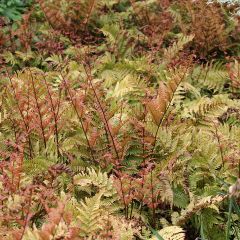
Dryopteris erythrosora - Copper Fern
- Height at maturity 70 cm
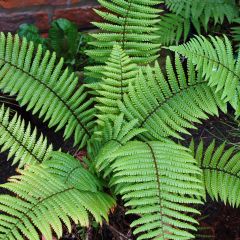
Dryopteris wallichiana - Wood Fern
- Height at maturity 1,50 m
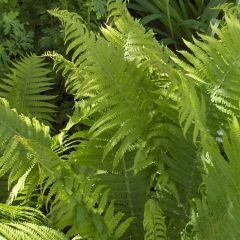
Dryopteris filix-mas - Male Fern
- Height at maturity 1 m

Dryopteris cycadina - Black Wood Fern
- Height at maturity 80 cm
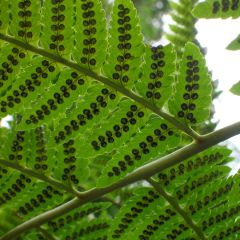
Dryopteris goldieana - Giant wood fern
- Height at maturity 1,50 m
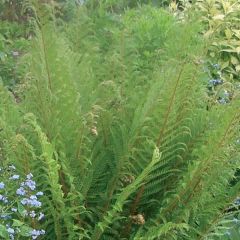
Dryopteris affinis - Scaly Male Fern
- Height at maturity 1,20 m
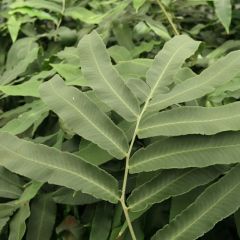
Dryopteris sieboldii - Japanese Fern
- Height at maturity 60 cm
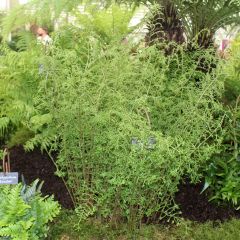
Dryopteris filix-mas Linearis Polydactyla - Male Fern
- Height at maturity 70 cm
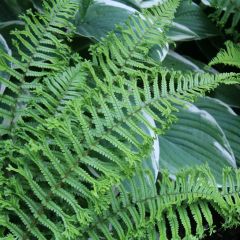
Dryopteris affinis Cristata - Scaly Male Fern
- Height at maturity 90 cm
Discover other Dryopteris
View all →Available in 2 sizes
Available in 2 sizes
Available in 2 sizes
Available in 2 sizes
Available in 1 sizes
Available in 2 sizes
Available in 1 sizes
Available in 1 sizes
Available in 2 sizes
Available in 2 sizes
Planting
Where to plant?
Like most ferns, Dryopteris need a cool, shaded position! Place them in woodland or at the base of trees. Avoid very dense shade. They prefer bright sites sheltered from scorching sun. Exposure depends on your location: Dryopteris should be grown in shade if you live in the Mediterranean basin, whereas in northern France you can more easily place them in sun. In all cases, preferably choose a position sheltered from wind. However, Dryopteris are very hardy and do not need winter protection.
Dryopteris prefer light, humus-rich soil. Ideally use woodland soil, such as that found in forest. Do not hesitate to add well-rotted compost to enrich soil and improve its structure. This encourages humus formation, makes soil lighter while improving water retention and mineral availability. Dryopteris also prefer acidic or neutral substrates.
Ferns are ideal for composing a woodland garden with a natural style. They are excellent for dressing the base of trees and shrubs, and their spreading foliage brings attractive volume and texture to borders and beds! As they also like cool, fairly moist spots, you can plant them near a pond or stream. They can also find a place in a shaded rockery. For this use, we particularly recommend the Dryopteris sieboldii.
When to plant?
You can plant Dryopteris in autumn, around October, or in spring, around April. The most important thing is to avoid periods of frost or extreme heat.
How to plant?
Dryopteris are light, delicate plants that bring a lush effect to the garden. Do not hesitate to plant them in groups to obtain a strong massing effect. They can form a superb green setting that enhances other flowering plants.
- Once you have found the ideal location for your Dryopteris, place the root ball in a basin of water. This will help establishment and subsequent watering.
- While it soaks, dig a planting hole about twice the size of the root ball.
- Add well-rotted compost to enrich the soil.
- Plant your Dryopteris.
- Backfill around it, then water generously.
- Apply mulch around your fern. You can use, for example, woodchip (BRF) or dry fronds. This prevents soil from drying out too quickly, and the mulch will decompose to enrich soil with humus. It also limits weed growth.
Dryopteris can also adapt to container or tub culture. Choose a large container with drainage holes in the base. Place a layer of clay pebbles or gravel to avoid waterlogging. Then add potting compost, preferably mixed with heather soil. Position the fern, fill in with substrate then water generously. Place the pot in a shaded spot.
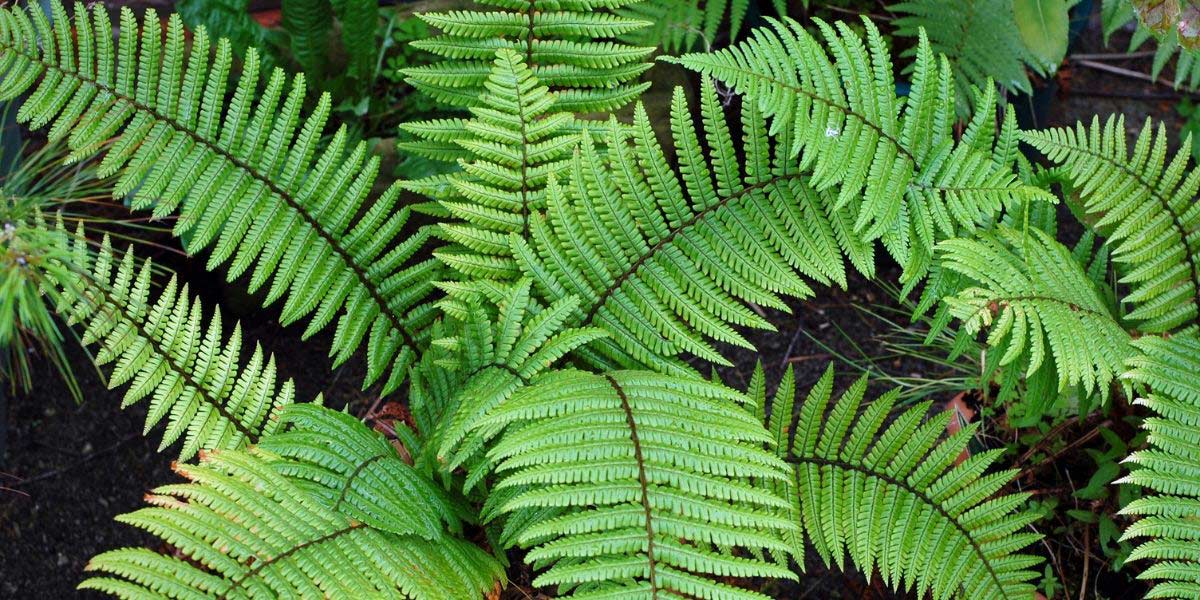
Dryopteris wallichiana (photo David Wright)
Read also
Ferns: how to choose them?Care
Dryopteris requires very little maintenance. It is a plant that manages quite well on its own without intervention. Moreover, it is rarely affected by parasites or diseases. However, if you grow it in a pot, it will need a little more care, notably regular watering. Similarly, if you plant it in the ground, during the year of planting we recommend watering to prevent it suffering from drought while it becomes established. Afterwards, Dryopteris will be more tolerant of drought.
You can add a little compost around your Dryopteris each spring to nourish the soil. You can also renew the mulch by spreading some around the stump from time to time. Use, for example, ramial chipped wood, pine bark or dried fronds. Place it well all around the young plant, avoiding placing any on the crown of fronds.
If the species you grow is deciduous, cut back withered fronds in early spring for aesthetic reasons and to encourage development of new fronds.
Multiplication
Sowing spores
Dryopteris, like other ferns, do not produce seeds but spores that can be harvested and sown! However, this operation is more delicate than a standard sowing, as particular conditions must be observed. Sowing must be carried out on sterile, moist substrate, in a confined environment.
- Look on undersides of fronds to locate spores. When ripe they are brown and detach by themselves. Cut a frond fragment bearing spores and place it in a paper envelope. As it dries, spores will be released and form a fine brown dust.
- Next, to sow them, take a clean transparent container, plastic or glass.
- Fill it with potting compost mixed with a little sand. Then moisten it.
- Sterilise substrate by placing it in a microwave oven for 10 minutes.
- You can then scatter spores over surface of substrate.
- Place a transparent lid on container (or, failing that, cling film), to maintain a confined, humid environment.
- Place sowing in a bright spot, out of direct sunlight.
- Now all that remains is to wait!
- As soon as young fronds appear, you can remove the lid.
For more information and advice on sowing fern spores, discover our dedicated advice sheet.
Division of clumps
Dryopteris can also be propagated by dividing clumps in spring or autumn. This technique is quicker and easier than sowing spores, provided you have well-developed plants. Choose a large, well-formed clump, then carefully lift it out. Remove excess soil if necessary. Divide clump by cutting stump with a knife, ensuring each fragment has fronds and roots. Make a clean, neat cut. Replant fragments immediately in a new location or in pots, then water generously.
Association
As they grow naturally in cool, shaded conditions, Dryopteris will thrive in a woodland garden, sheltered from sun by large trees and bushes. Combine them with Solomon’s seal, sweet woodruff, Lamium, Brunnera, Geranium nodosum… You will achieve a very natural effect, evoking a true woodland stroll!
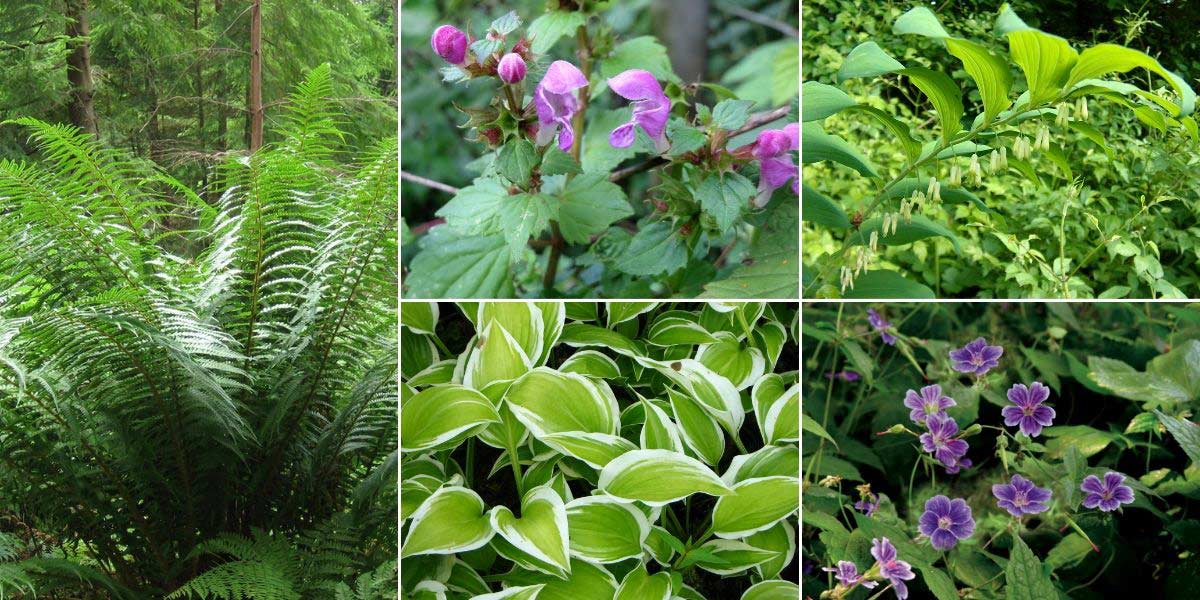
Dryopteris fit wonderfully into woodland gardens, creating a very natural feel! Dryopteris affinis (photo MPF), Lamium maculatum, Polygonatum multiflorum (photo Markus Hagenlocher), Hosta ‘Emily Dickinson’, and Geranium nodosum ‘Le Clos du Coudray’
Dryopteris will also find a place in a shaded rock garden. Choose, for example, Dryopteris sieboldii, which has fronds divided into broad, entire pinnules, matt green. Plant it alongside other small rock-garden plants such as Ajuga reptans, Epimedium, Corydalis, Saxifrages, Tiarella… You can also include other ferns, such as Athyrium niponicum or hart’s-tongue fern.
You can easily incorporate them into a modern, graphic garden. Their triangular, divided fronds make a striking feature! Plant alongside Japanese maples, horsetails, hostas, ophiopogons… Also make use of the very fine foliage of ornamental grasses (Carex, Stipa, etc.)
With their large, lush fronds, ferns are ideal for creating an exotic-style garden. Choose, for example, Dryopteris goldieana or Dryopteris erythrosora for the beautiful coppery or golden tints their foliage takes in spring. Plant with tree ferns, palms, castor oil plant, Tetrapanax, bamboos, Hedychium, Colocasia… Also discover the superb Datisca cannabina, with finely divided leaves. Create a jungle garden, with luxuriant, very large foliage!
For a more delicate, romantic look, Dryopteris also fit well in cottage gardens. Their elegant, graceful fronds beautifully complement flowering of delphiniums, hydrangeas, foxgloves, roses, astrantias… Opt for delicate flower colours in blue–mauve–white tones. These will be highlighted by generous fern foliage!
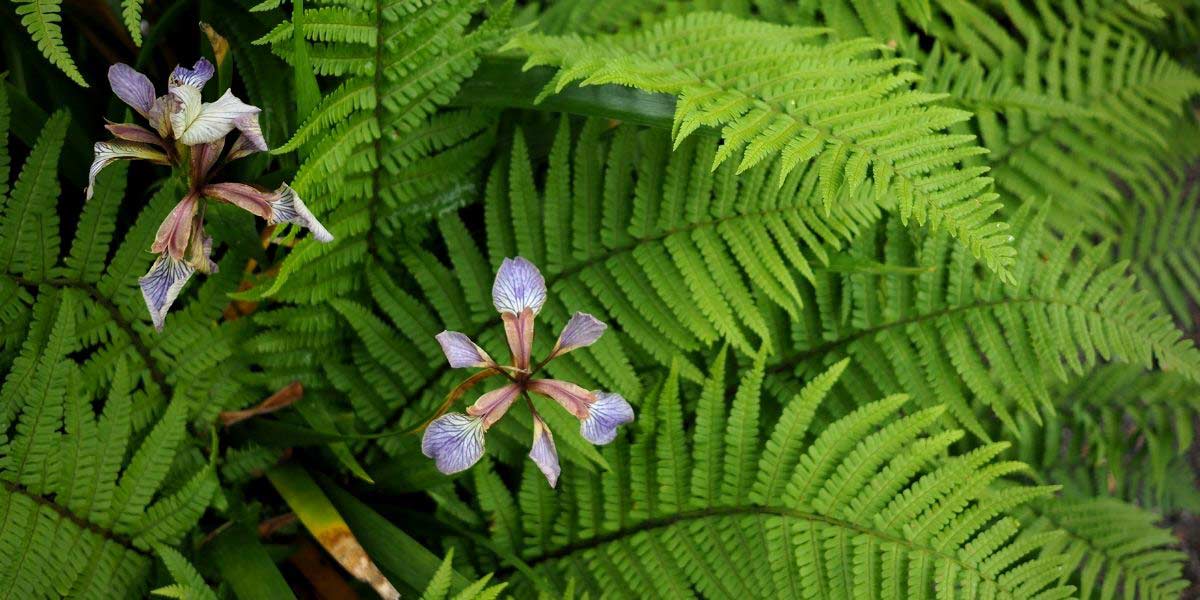
Dryopteris affinis and Iris foetidissima
For more ideas and inspiration, discover our advice sheet: “Ferns: 9 easy association ideas to succeed!”
Useful resources
- Discover our wide range of Dryopteris!
- Our article on ferns planting
- Fernatic, a French website for fern enthusiasts, with plenty of information and cultivation advice
Frequently asked questions
-
My soil is calcareous, can I grow Dryopteris?
Most Dryopteris prefer acidic or neutral soils, but some species are tolerant of calcareous conditions. This is the case, for example, of Dryopteris filix-mas and Dryopteris lepidopoda, which in the wild are sometimes found on calcareous soils. For other species, and to avoid taking risks, if your soil is calcareous you can pot Dryopteris in a mix of potting compost and heather soil.
- Subscribe!
- Contents
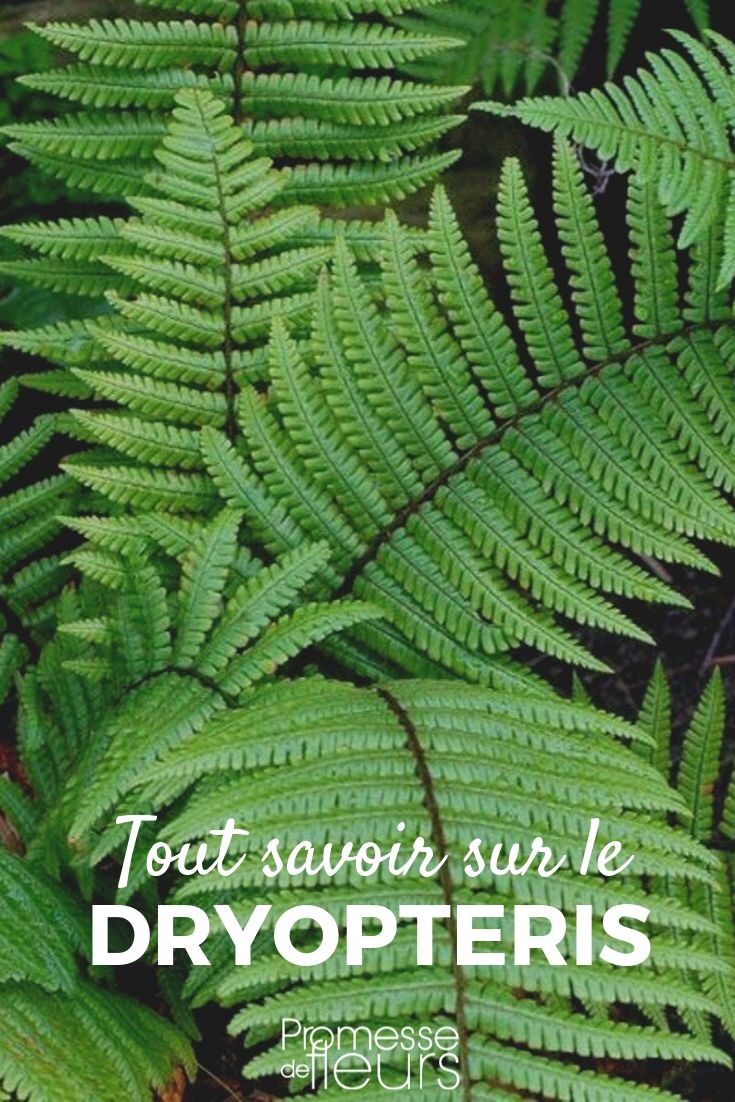




































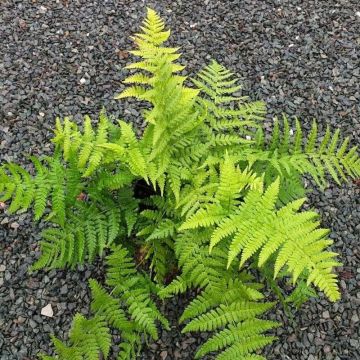
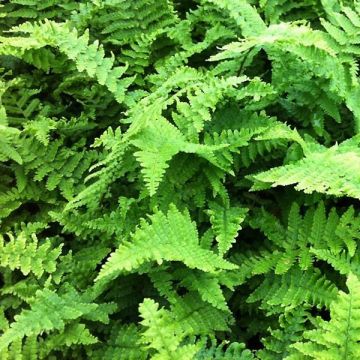
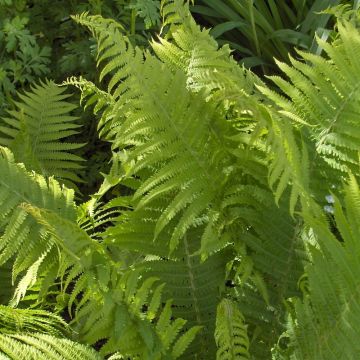
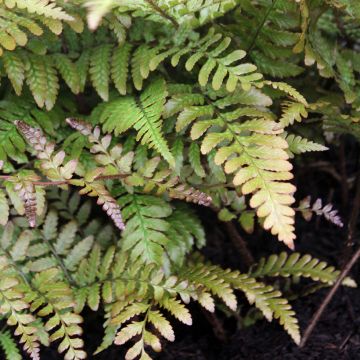

Comments